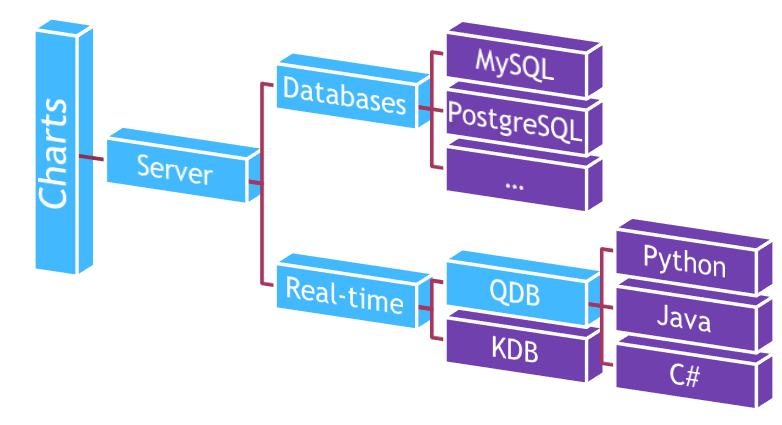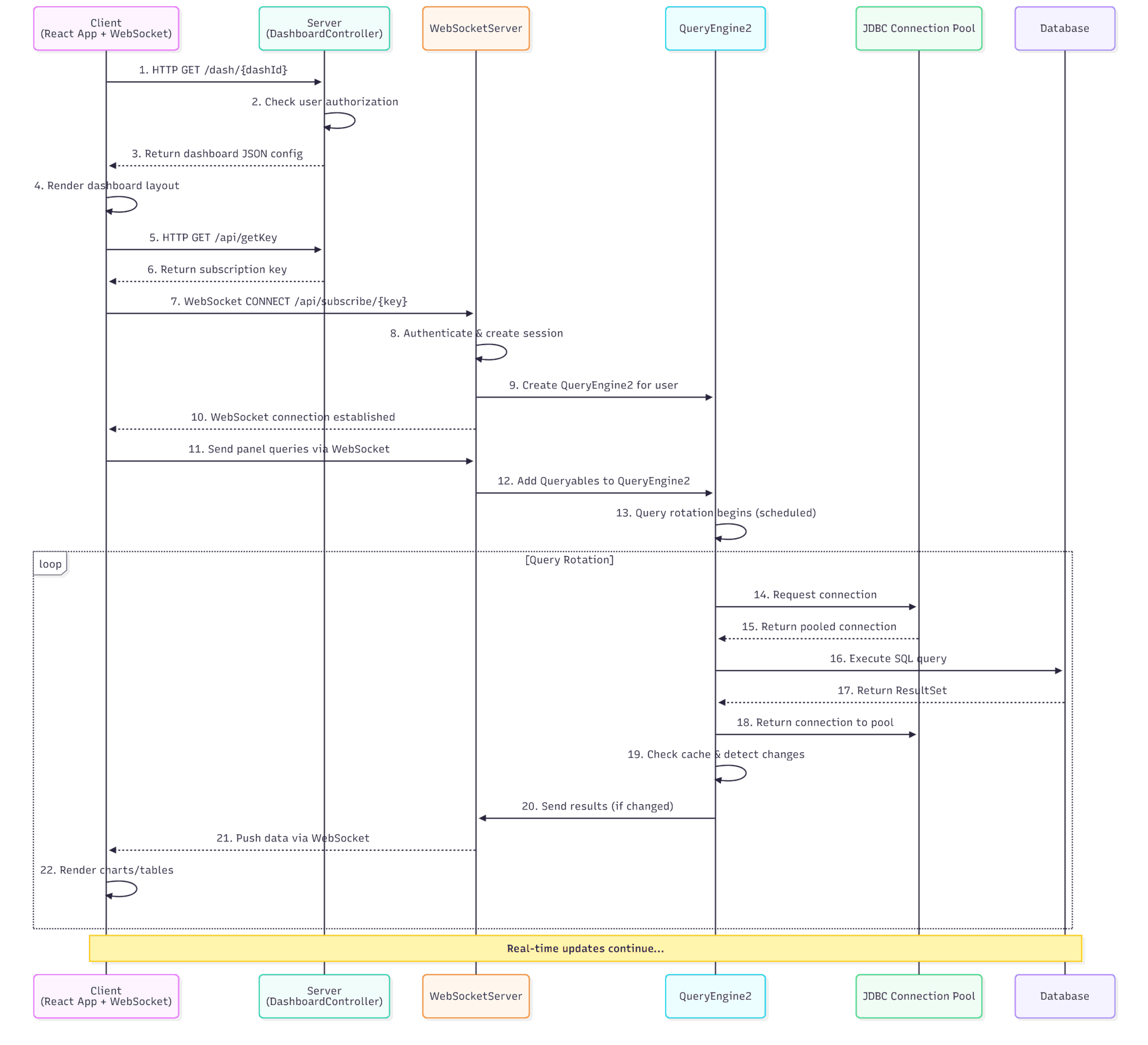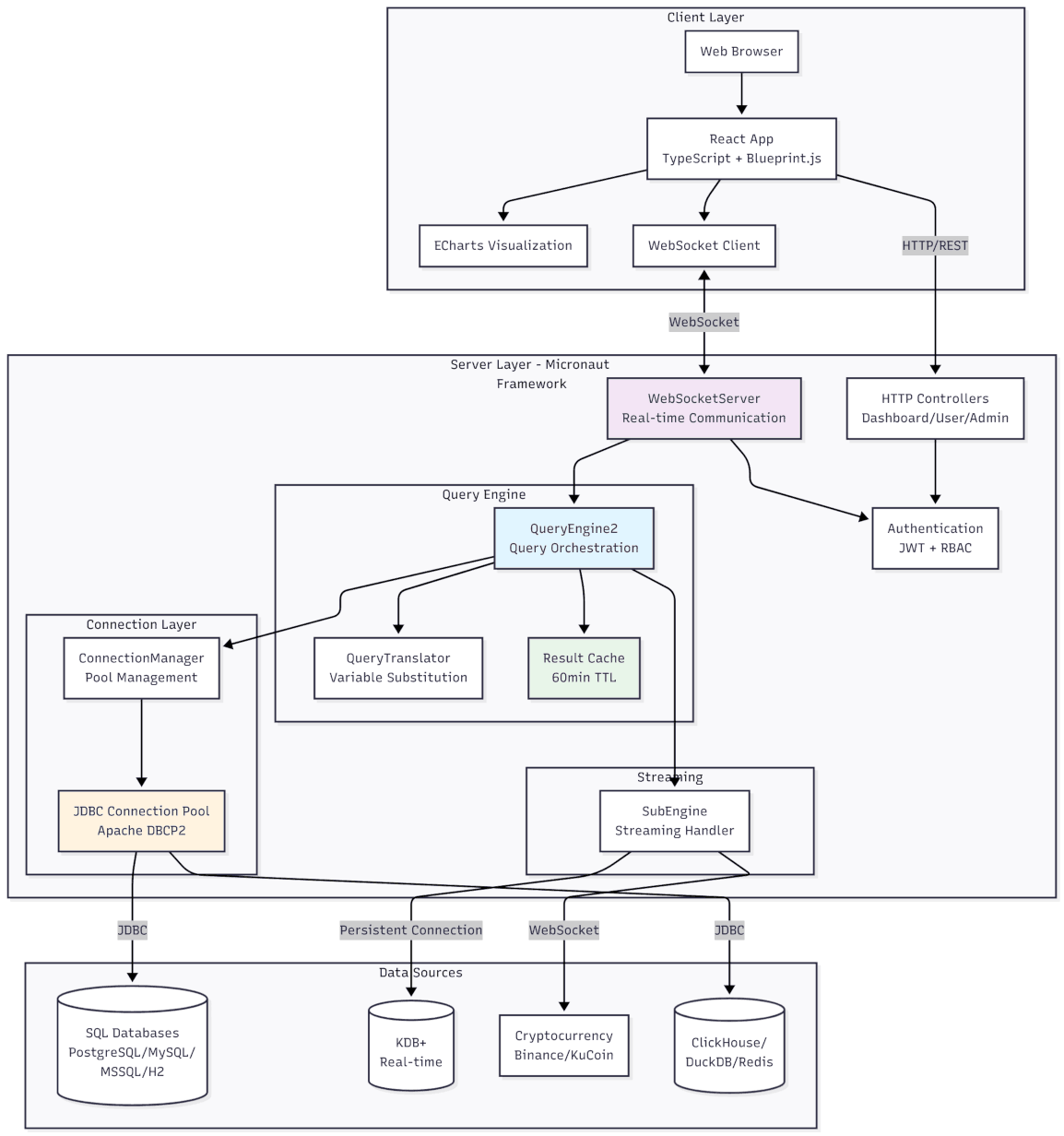Pulse Real-Time Dashboards Architecture

Pulse Architecture Documentation
Table of Contents
High-Level Overview
What is Pulse?
Pulse is an open source real-time visual analysis, email reporting and alerting tool that enables data analysts to build interactive data applications. It supports 40+ databases including kdb+, PostgreSQL, MySQL, MS SQL Server, ClickHouse, and wire-compatible databases like TimescaleDB, QuestDB, and CockroachDB.
Data Flow
Starting from the front-end, when a user connects:
- User Interface
- The user downloads a modern single-page React-based application that uses a fast charting library (ECharts) to provide animated, interactive charts
- When a dashboard is opened, it opens a WebSocket connection to allow real-time fast updates from the server
- Server Security & Control
- The server controls security, authentication and data access controls
- All data queries are validated and sanitized before execution
- User permissions determine which dashboards and data sources can be accessed
- Data Source Connectivity
The server can connect to either real-time or database data sources depending on the dashboard configuration:
Databases (Polling Mode)- You have existing data in a MySQL/PostgreSQL/kdb+ or any JDBC compatible database
- The server will poll the data on a schedule the author has set, only taking action on changes
- Results are cached and shared across users viewing the same dashboard
- Connection pooling ensures efficient resource usage
- The server will create a new thread per client that subscribes to that external source
- The real-time QDB/KDB will push updates to the server and onwards to the client
- Supported streaming sources include: KDB+, Binance, KuCoin cryptocurrency feeds

Security Architecture
Authentication Endpoint
The server can be configured to check HTTP endpoints for authentication:
http://qdb-master.com/?.z.pw[((username));((password))]
This endpoint is queried each time a new user logs in. The .z.pw function can either:
- Return
true/falseto indicate authentication success/failure - Return the name of a role, which will be assigned to the user
Assuming positive authentication, the server will issue a JWT token that allows continued access for a time period without needing to call the REST API every time.
Authorization Endpoint
http://qdb-master.com/?isAuthorized[((username));((dashboardName))]
This endpoint is queried each time the user requests to open a dashboard. If it returns true, access is granted; anything else is assumed to be false.
Built-in Security
- JWT token-based authentication
- Role-based access control (RBAC)
- Team-based permissions
- Dashboard ownership and sharing controls
- SQL injection prevention through parameterized queries
- HTML sanitization for user-generated content
Developer Architecture

Technology Stack
Frontend
- React 18 with TypeScript
- Blueprint.js UI framework
- ECharts and ECharts-GL for visualization
- FlexLayout for dashboard layouts
- WebSockets for real-time communication
Backend
- Java 11+
- Micronaut 3.8.7 framework
- H2 embedded database for configuration
- Apache Commons DBCP2 for connection pooling
- WebSocket support via Micronaut
Build System
- Gradle 7.6.4 multi-module build
- npm/webpack for client bundling
- Shadow JAR for server packaging
Project Structure
sqldash3/
├── client/ # React/TypeScript frontend
│ ├── src/
│ │ ├── components/ # React UI components
│ │ ├── engine/ # Query engine & result processing
│ │ ├── pro/ # Premium features
│ │ └── App.tsx # Main application entry point
│ └── build/ # Compiled client assets
├── server/ # Java/Micronaut backend
│ ├── src/main/java/com/sqldashboards/
│ │ ├── webby/ # Web controllers & WebSocket
│ │ ├── dashy/ # Query engine core
│ │ ├── shared/ # Connection management
│ │ └── pro/ # Premium server features
│ └── lib/ # Bundled database drivers
└── build.gradle # Root build configuration
Key Design Patterns
- Repository Pattern: Database entities (Dashboard, User, Team) use Micronaut Data repositories
- Connection Pooling: Apache DBCP2 manages JDBC connection pools per data source
- Query Engine Pattern: Centralized query execution with caching and result sharing
- WebSocket Communication: Real-time bidirectional communication between client and server
- Observer Pattern: QueryEngine uses listeners to notify clients of data changes
- Strategy Pattern: Different SubEngine implementations for streaming vs polling
Client Architecture
Core Technologies
- React 18: Component-based UI framework
- TypeScript: Type-safe JavaScript
- Blueprint.js: Enterprise-grade UI components
- ECharts 5: Advanced charting library with WebGL support for 3D charts
- FlexLayout: Flexible, dockable panel layouts
- React Router: Client-side routing
- Axios: HTTP client for REST API calls
- WebSocket-TS: WebSocket client wrapper
Major Modules
Engine (client/src/engine/)
The engine is responsible for query processing and result transformation:
queryEngine.tsx: Manages query execution lifecycle, caching, and WebSocket communicationqueryModel.tsx: Defines data models for queries, results, and configurationsqueryTranslator.tsx: Translates user variables and parameters into SQL querieschartResultSet.tsx: Transforms database results into chart-compatible formatsViewStrategy.tsx: Determines how to render results (chart, table, metric, etc.)
Key Features:
- Query result caching to reduce server load
- Automatic reconnection on WebSocket failure
- Support for parameterized queries with variable substitution
- Real-time data updates via WebSocket subscriptions
Client Data Flow
User Action → React Component → Query Engine → WebSocket/HTTP
↓
Query Translation
↓
Server Communication
↓
Result Processing
↓
Chart/Table Rendering
Server Architecture
Core Framework
Pulse server is built on Micronaut 3.8.7, a modern, JVM-based framework optimized for:
- Fast startup times
- Low memory footprint
- Compile-time dependency injection
- Native cloud support
2. Query Engine (com.sqldashboards.dashy)
The query engine is the heart of Pulse's data processing:
QueryEngine2: Main query orchestration engine
- Manages query execution scheduling
- Maintains query result cache
- Handles variable substitution
- Coordinates multiple Queryables (dashboard panels)
- Implements smart caching - multiple users viewing same data = single query
Query Lifecycle:
- User opens dashboard → QueryEngine2 created for user session
- Dashboard panels added as Queryables
- QueryTranslator substitutes variables in SQL
- Query scheduled for execution
- Results cached and sent to client via WebSocket
- On data change or schedule, query re-executed
- Only changed data sent to client (delta updates)
Queryable: Represents a single dashboard panel query
- Query SQL text
- Refresh rate configuration
- Server connection reference
- Result format specification
QueryTranslator: SQL query transformation
- Variable substitution:
{{variable}}→ actual value - Parameter validation and escaping
- Special variable support:
{{USER}},{{ALL}}, etc.
SubEngine (Interface): Streaming data handler
KdbSubEngine: KDB+ streaming subscriptionsBinanceSubEngine: Binance cryptocurrency feedsKucoinSubEngine: KuCoin cryptocurrency feeds
Each SubEngine runs in a separate thread, maintaining a persistent connection to the streaming source and pushing updates to the query engine.
3. Connection Management (com.sqldashboards.shared)
ConnectionManager: Central connection management
- Thread-safe with concurrent collections
- Manages JDBC connection pools per data source
- Query result caching
Connection Pooling: Uses Apache Commons DBCP2 with GenericObjectPool:
- Connection validation on borrow
- Idle connection eviction
- Maximum connections per pool
- Connection timeout configuration
ServerConfig: Database connection configuration
- JDBC URL, username, password
- Database type (PostgreSQL, MySQL, KDB+, etc.)
- Polling vs streaming mode
- SSL/TLS settings
4. JDBC Integration
Query Execution Flow:
ConnectionManager.executeQuery(ServerConfig, SQL)
↓
Get Connection from Pool
↓
Create PreparedStatement
↓
Execute Query (with timeout)
↓
Process ResultSet
↓
Convert to Internal Format
↓
Return Connection to Pool
Supported Databases (via bundled JDBC drivers in server/lib/):
- PostgreSQL 42.7.4
- MySQL 9.1.0
- MS SQL Server 11.2.0
- H2 2.3.232 (embedded)
- DuckDB 1.4.1.0
- Redis JDBC 1.4
- KDB+ (custom driver)
5. Query Rotation & Scheduling
How Query Rotation Works:
Scheduler Thread: QueryEngine2 runs a scheduled executor
scheduler = Executors.newSingleThreadScheduledExecutor(); scheduler.scheduleAtFixedRate(this, 0, milliseconds, TimeUnit.MILLISECONDS);Query Queue: Queryables are rotated through in round-robin fashion
- Priority queue for immediate execution requests
- Fair scheduling ensures all panels get updated
Change Detection:
- Results are compared with cached previous results
- Only changed results trigger WebSocket updates
- Reduces network traffic and client processing
Smart Caching:
- Same query from multiple users executes once
- Results shared across sessions
- Cache key:
serverName + SQL + variables - 60-minute expiration, 100 entry maximum
Rate Limiting:
- Per-query refresh rate (30 seconds default)
- Throttling for slow clients
- Prevents overwhelming the server or databases
6. Data Serialization
ResultSetSerializer: Converts JDBC ResultSets to JSON
- Type detection and conversion
- Date/time/timestamp handling with timezone support
- Binary data encoding
- NULL handling
- Special column naming conventions:
_SD_BG: Background color_SD_FG: Foreground colorSD_LINK: Clickable links
7. Security Implementation
Authentication Flow:
- User submits credentials to
/login UserService.authenticate()validates credentials- JWT token generated with user claims
- Token returned to client
- Subsequent requests include Bearer token
- Micronaut Security validates token on each request
Authorization:
- Dashboard ownership and team membership checked
- Role-based permissions (ADMIN, EDITOR, VIEWER)
- Database connection permissions per user/team
- Query result row-level security (via database views)
HTML Sanitization:
// OWASP Java HTML Sanitizer
import org.owasp.html.PolicyFactory;
// User HTML content sanitized before rendering
8. Database Schema
H2 Embedded Database (pulsedb3.mv.db):
- Stores user accounts, teams, roles
- Dashboard configurations and versions
- Database connection configs
- Report schedules
- Audit logs
Flyway Migrations: Version-controlled schema updates
Server Build & Deployment
Shadow JAR (pulse.jar):
- All dependencies bundled
- Embedded Netty HTTP server
- Client assets included in
/public - Bundled JDBC drivers
- ~50-80 MB single executable JAR
Startup Sequence:
- Initialize Micronaut context
- Load configuration from
application.ymland environment - Initialize H2 database, run Flyway migrations
- Register JDBC drivers (PostgreSQL, MySQL, custom drivers)
- Start ConnectionManager
- Start Netty HTTP server on configured port (default 8080)
- Serve client assets from
/public - Initialize WebSocket endpoints
- Log startup URL and admin credentials
Configuration Sources (in order of precedence):
- Environment variables
- System properties
application.yml- External config files in
pl-config/directory - Built-in defaults
Component Interactions
Dashboard Load Sequence
1. Client: HTTP GET /dash/{dashId}
↓
2. Server: DashboardController.getDashboard()
↓
3. Check user authorization
↓
4. Return dashboard JSON config
↓
5. Client: Render dashboard layout
↓
6. Client: HTTP GET /api/getKey
↓
7. Server: Generate subscription key
↓
8. Client: WebSocket connect /api/subscribe/{key}
↓
9. Server: WebSocketServer.onOpen()
↓
10. Server: Create QueryEngine2 for session
↓
11. Client: Send panel queries via WebSocket
↓
12. Server: Add Queryables to QueryEngine2
↓
13. Server: Query rotation begins
↓
14. Server: Send results via WebSocket
↓
15. Client: Render charts/tables
↓
16. [Real-time updates continue...]
Real-Time Streaming Flow
1. Dashboard configured for streaming source (KDB+/Binance)
↓
2. QueryEngine2 detects streaming server
↓
3. Create SubEngine for streaming source
↓
4. SubEngine.run() in separate thread
↓
5. SubEngine connects to external source
↓
6. Subscribe to data updates
↓
7. On data arrival:
- SubEngine receives update
- Notifies QueryEngineListener
- QueryEngine2 formats result
- Sends to client via WebSocket
↓
8. Client receives update, renders immediately
Query Caching Strategy
User A opens Dashboard X with Query Q1
↓
Execute Q1, cache result with key K1 = hash(server, query, variables)
↓
User B opens Dashboard X with same Query Q1
↓
Check cache for K1 → HIT
↓
Return cached result (no database query)
↓
Both users receive same data updates when Q1 re-executed
Performance Optimizations
Client Side
- Virtual scrolling for large tables (react-window)
- Chart data point sampling for performance
- Debounced user input
- Lazy loading of dashboard components
- WebSocket message batching
Server Side
- JDBC connection pooling (reduces connection overhead)
- Query result caching (prevents duplicate queries)
- Smart scheduling (queries execute only when needed)
- Result change detection (only send deltas)
- Parallel query execution (ExecutorService thread pool)
- Connection validation and eviction
Network
- WebSocket for efficient real-time updates
- JSON compression
- Delta updates (only changed data)
- Heartbeat for connection health
Deployment Considerations
System Requirements
- Java 11+ JRE (bundled in packaged versions)
- 4GB RAM minimum (8GB recommended for production)
- Modern web browser with WebSocket support
Scaling
- Multiple instances can run behind a load balancer
- Sticky sessions required (for WebSocket affinity)
- Shared database file system or external database recommended
- Connection pools prevent database overload
Conclusion
Pulse's architecture is designed for:
- Real-time Performance: WebSocket communication and efficient query execution
- Scalability: Connection pooling, caching, and smart query rotation
- Flexibility: Support for 40+ databases and streaming sources
- Security: JWT authentication, RBAC, and SQL injection prevention
- Developer Experience: Modern stack (React, Micronaut) with TypeScript type safety
The separation between client and server, combined with the powerful query engine and flexible connection management, allows Pulse to serve both traditional database dashboards and real-time streaming data visualizations efficiently.
